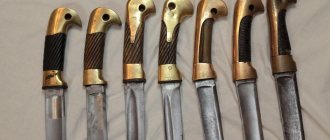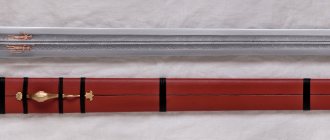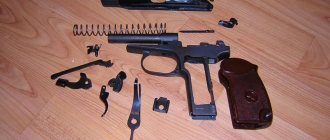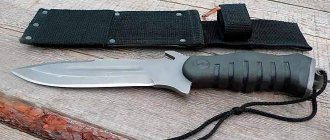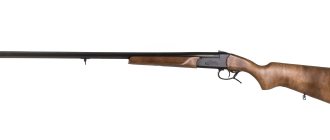A halberd is a type of polearm bladed weapon with a combined tip, which included a spear point and an ax (axe) blade with a sharp butt. This is a piercing-cutting edged weapon; in fact, its creators wanted to combine the best properties of a battle ax and a spear. The halberd was a mega-popular weapon of medieval infantry; its “finest hour” was the European wars of the 14th–16th centuries; it allowed foot soldiers to very effectively resist enemy cavalry.
After the advent and widespread use of firearms and the abandonment of heavy metal armor, the combat value of the halberd began to rapidly decline. However, this type of bladed weapon was used for a long time during parades and ceremonies. The Vatican's Swiss Guard is still armed with halberds. In Russia, until the middle of the 19th century, lower police ranks (budochniks) were armed with halberds.
In terms of its purpose, another type of medieval pole weapon is very close to the halberd - the polex. However, its design had some differences.
There were a large number of varieties of halberds; they differed in the shape of the axe, the size and shape of the spear tip, and the presence or absence of a butt. Some halberds, instead of a sharp ax head, had hooks, with the help of which it was convenient to pull the rider off the horse. As a rule, halberds of different countries had their own characteristics: there were German, Tyrolean, Dutch and Russian halberds.
Analogues of these weapons also existed in the East. The Chinese halberd Guan Dao, which was owned by the legendary hero Guan Yu, is well known. It had a long shaft with a warhead in the form of a curved blade. The overall dimensions of the weapon were approximately two meters. Sometimes the butt of the blade was equipped with a piercer, which could be used to defeat heavy armor or parry enemy blows. The total weight of these Chinese weapons could reach five kilograms.
It should be noted that many experts in the field of historical edged weapons do not at all classify Guan Dao as halberds. In its appearance, Guan Dao is more reminiscent of a medieval European glaive or Japanese naginata; this Chinese halberd is still used in wushu.
History of the first use of gunpowder
Greek fire
It is difficult to determine when fireworks and rockets began to be made from saltpeter. However, the fact that the Chinese invented guns is undeniable. Chinese chronicles from the 7th century describe the process of throwing shells from cannons using an explosive mixture. At the same time, they learned to “grow” saltpeter. For its formation, special pits with manure were created. When the method of obtaining saltpeter spread, its use for military operations became more common. After rockets and flamethrowers, firearms were invented.
The Arabs used gunpowder in the 11th century. Europeans acquired information about the properties of saltpeter at the beginning of the 13th century, after the conquest of Constantinople by the Crusaders. European scientists studied the method of creating "sea fire", and by the mid-13th century there were descriptions of exploding gunpowder.
According to the standard, gunpowder consisted of 60% saltpeter, 20% sulfur and charcoal. The first component is the main one, and sulfur was not used in all formulations. It was needed to ignite the substance from a spark. If other methods of ignition were used, it was not required.
Charcoal is also not the most important component. It was often replaced with cotton wool, dried sawdust, cornflower flowers or brown coal. This only changed the color of the composition and its name - this is how white, brown, blue and black powder were distinguished.
Varieties of halberds and problems of classification of these weapons
The classification of halberds is very complex and confusing, however, the same can be said about the classification of edged polearms in general. The main problem is the lack of any unification in the production of weapons in the Middle Ages: each blacksmith-gunsmith made products according to his own understanding. This era gave us dozens of types of halberds - the most bizarre combinations of ax blades, spear tips, coins, hooks and other elements. Many of them have their own names.
Even the classification of an ordinary spear is very difficult, although it would seem that it could be simpler than an ordinary stick with a metal tip. However, not everything is so simple here: there were throwing spears, pikes up to five meters long, knightly spears and other varieties of these weapons. Halberds can be called the “cousins” of the spear and the situation with them is even more complicated.
Some authors classify as halberds only weapons of the “classical” form, with an ax and a spear head. Others include in this group almost any pole weapon equipped with a blade of various shapes and sizes. In this case, halberds include glaives, protazans, Russian berdyshes, guizarms and many other types of weapons.
If you simply add a spear and an ax, you get not a halberd, but a polex - another pole weapon that was very popular in the Middle Ages. The polex was usually shorter than a halberd; its length, as a rule, did not exceed human height. Its “warhead” included an axe, a spear point, and a war hammer. Moreover, the tip of the polex, as a rule, had a collapsible design. The halberd was usually longer (up to 2.5 meters) and its tip was solid. The blade of a halberd ax, as a rule, had a short length, which contributed to an increase in the force of the blow. We can also add that poleaxes were also very common, and they were used not only on the battlefield, but also in tournaments.
If we talk about the classic halberd, they are often classified according to the shape of the ax blade. Early types of these weapons had a convex blade, which was as close as possible to an ordinary ax or poleaxe. Later, the cutting edge lost its curve and became flat, which made the blow more powerful. The most advanced type of this weapon is a halberd with an ax in the shape of a crescent; it had the highest combat qualities and could cope with almost any armor.
Partisan. This is a type of pole weapon, which is also classified as halberds. Protazans had a long and wide tip, mounted on a shaft of considerable size (up to 2.5 meters). In its shape it was similar to a double-edged sword, which could deliver powerful stabbing blows. At the bottom of the tip there were two petals directed to the sides, perpendicular to the longitudinal axis of the weapon. With their help, it was possible to block the blows of enemy weapons and throw them aside.
Berdysh. A type of halberd with an ax (axe) in the shape of a crescent without a spear point. The shaft of the reed (ratovishche) had a length of approximately 1.5 meters, the tip often had a second attachment point at the lower end of the blade. Berdysh were very popular in Rus', Muscovy, and Poland. These weapons were mainly used for chopping blows, but the upper sharp part of the ax could also be used to stab. Unlike most types of polearms, the reed could also be used in close combat. In addition, Moscow archers often used it as a stand for firearms.
Glaive. A polearm with a tip in the form of a wide blade, which was put on using a socket. The glaive could deliver both piercing and cutting blows; the blade could be supplemented with spikes or hooks. In Rus' there was an almost complete analogue of the European glaive, it was called the owl.
Guizarma. A type of halberd with a hook-shaped tip with a sharpened inner side. It is considered a further development of the battle scythe and glaive. Some guizarmes had a thin spear-shaped tip, which could also be used to deliver stabbing blows. These weapons were especially convenient for cutting the tendons of horses and pulling riders off them.
What is a Japanese naginata? This weapon is a type of Russian owl, which, in turn, is a type of glaive. The latter is considered a type of halberd, while experts never classify the owl or naginata as halberds. It's all so confusing.
Description of the halberd
The halberd was a shaft, the length of which could vary. Initially, the halberds were 2 meters long. One end of the shaft was blunt; on the other side, a spear point in combination with an ax with a sharp butt was attached to the shaft. The tip of the halberd was often equipped with a hook. There were halberds without a spear point, as well as boarding halberds equipped with a large hook and a longer (about 3 meters) shaft for hooking onto the side of an enemy ship.
In some cases, strips of metal were added to the shaft to enhance the strength of the shaft itself and allow the wielder to strike with greater force. In different parts of Europe, the design of halberds could differ, with various innovations added to the design.
Naginata
The famous eastern relative of the glaive, the most typical example of a light fencing ax. Its blade is long and noticeably curved, but noticeably less massive than that of European axes, more like a katana (and of appropriate quality); It is attached to the shaft not with worker-peasant nails, but rather cunningly mounted on it.
The appearance of naginatas dates back to times much older than halberds and axes in Europe: approximately the 7th century AD. And the famous naginata-do is even older than the art of sword fighting: the first school of naginata fencing dates back to 1168, sword fencing - 1350.
Initially, the naginata was heavier (somewhat similar to the dadao) and served as the main weapon of the warrior. Subsequently, it became noticeably lighter and gained great popularity, firstly, as a monk’s weapon, and secondly, as a women’s weapon. Girls of the samurai family learned to handle it.
It’s interesting that historians’ supposed reason for making naginata easier is precisely the emergence of a fighting school. Of course, they practiced with light wooden naginatas, not combat ones - and the techniques turned out to be designed for them. The blade itself had to be lightened.
Today the naginata is a sporting weapon, very popular in Japan as such.
Poleaxes in art
up
Several different treatises, including Hans Talhoffer's fechtbuch of 1467 and the ancient Wallenstein Manuscript, show the use of roleaxes in the context of judicial duels or tournaments.
A number of illustrations also show the use of poleaxes in battles in the 14th and 15th centuries, including a description of the Battle of Poitiers. Illustrations of the Chronicle of Froussard, made at the end of the 15th century, depict a wide variety of poleaxes.
| In this illustration from the novel about Alexander, the knights beat the monster with an ax and godendag. | Godfrey Bullen, from tapestry 1420 | The use of a glaive in a painting depicting the death of St. Lambert |
| On the warrior’s left side we see the so-called Lochaber Axe, that is, a Guizarma with two eyes on a shortened shaft, and 2 battle axes. | Poleax, Berdysh, Godendag, Gwizarma. Miniature of the Chronicle of the Abbey of Saint-Denis, late 14th century. Interesting details are described here | |
The Trajan Tapestry from Lausanne Cathedral, dated around 1450, clearly shows Trajan armed with a short poleax dispensing military justice, guarded by a warrior holding a longer poleax. This is how Caesar Trajan administers justice.
As Edward Eokeshot wrote, “Axes were used quite a lot at that time (V-IX centuries), but only some of them stood out among others in that they were used specifically as weapons, and not for the banal purpose of cutting down trees, for which they success could have been intended. They are often found in graves, but, in my opinion, one should not conclude from this that they served as an instrument of war: for any householder or landowner, the ax was such a necessary tool that its presence in the grave should not surprise anyone. Battle axes are often mentioned in the sagas, but they appear to have come into use in later times.
Strictly speaking, an ordinary household ax is a universal tool, and it is quite possible to imagine a woodcutter who, upon seeing an armed enemy, rushes at him with what was at hand, or even uses his tool as a throwing weapon. In this case, this is probably what delayed the process of further specialization - an ordinary ax was so well suited for any job that it was not soon thought of to be adapted for specific types of activity, namely, for battles.”
It is the one-handed combat ax that is somewhat different from the working one: firstly, the head is not well suited for cutting down trees, the shaft is reinforced with iron strips, and there is also a handle on the shaft.
“In the 11th century, continental warriors considered it (the ax) as a weapon unworthy of a noble man; only the Saxons and Scandinavians believed that he was suitable for everything except dishonorable deeds. However, at the beginning of the 12th century. it turned into a completely respectable weapon, and knights also fought with it in the 12th-13th centuries. The battle ax was used very widely. The chronicler Roger de Hoviden, describing the Battle of Lincoln, which took place in 1141, tells how Stephen, the most valiant and skillful of all the knights, but a worthless king, fought with an ax: “Then the king’s power became visible, like lightning he smashed some with a huge battle axe....”
Yue
An "intermediate link" between an ax and a halberd, the Chinese Yue ax is significantly heavier than most European halberds and is more similar to the type that is usually depicted in the game. Nevertheless, thanks to the weighted counterweight at the end, the yue is quite suitable for ax maneuvers, especially in the Chinese style - with a “staff” grip.
A relative of the yue is also considered the tiny “axe” tzuu yuanyan yue, something between a hatchet and a brass knuckle, the entire “shaft” of which is placed between the ends of the blade.
Axes in fantasy
Although there are a great variety of weapons of this class in fantasy, there are few known or particularly interesting examples among them. The fact is that, according to most novelists, a sword befits a hero, or, at worst, an ax (but without any frills), and elaborate blades on a long shaft are more appropriate for a villain or a monstrous monster.
Why is that? Don't know. Perhaps they are considered too “combatant” and not an individual weapon (which is not entirely correct, and even more so in a world inhabited by large monsters).
| Horse axes in "Shogun". |
There is also the problem of determining the period in earth's history to which the game world corresponds. This is a topic for a separate and interesting conversation; but it just so happens that the whole society is usually structured according to the model of approximately the 17th century, but weapons remain in the 14th century, when axes are just beginning their victorious march.
In David Eddings’s wonderful Elenia trilogy, one of the main characters, Sir Bevier, uses a lockaber (a siege knife, let me remind you) as his favorite weapon. Everything would be fine, but the poor fellow is waving at them while sitting in the saddle. Imagine this thing on a two-meter (minimum!) stick in the hands of a cavalryman!
In Brian Kim's "Monster Slayer", the Kalb ax is used when going to hit something large and scaly. As the hero explains, quite logically: “The dragon will not do me the courtesy of running into a spear or putting his paw under an ax. But the sword will not pierce the scales.”
The heroes of Yuri Nikitin (“Three from the Forest”) loved and valued axes; however, in the next novel, Gloom, the main ax-bearer among them, suddenly publicly betrayed his favorite weapon, declaring that “the club can do more.” True, this did not motivate me in any way.
The largest variety of axes (as well as swords, axes, spears and everything else) can be found in Henry Lyon Oldie's novel The Way of the Sword.
Use of medieval poleaxes
up
Poleaxes were a very popular military weapon, popular with both cavalry and infantry. Many surviving examples are admired for their high quality and decoration, and support the idea that poleaxes were used by wealthy soldiers. Although, in the Wallace Collection under number A925 we see an example of an undecorated poleaxe. Weapons without decorations were not considered valuable; they were usually not taken care of. Polexes were also a duel weapon. There is even a slightly modified type, called hache in French, which was used primarily for duels. This weapon had a 6-7 foot (194-220 cm) shaft and two disc guards on top and bottom.
| Codex Membranes, Chronicles of France 1388 | Detail of the Trajan Tapestry, 1450, note the poleax in the emperor's hand | From left to right: Voulge, Halberd, Protazan-runka |
Even a cursory examination of pictorial sources from the 14th to 16th centuries shows that warriors were often depicted using poleaxes in mass battles. Therefore, it is believed that poleaxes were used very widely. Indeed, the German name for poleaxes fussstreihammer roughly translates John Waldman as "infantry war hammer," indicating that poleaxes were used by infantry and militia. Foratio and Blackburn conclude that the skull injuries noted on bones from the Visby and Towtone mass graves are caused by various poleaxes.
Axes in games
In the last article we wrote about the role of each specific type of spades and spears in games. This trick won’t work with axes, and for a very simple reason: incredible chaos reigns in games with them, and weapons often look like one thing, are called like another, but act like a third. I have seen with my own eyes games where bec de corbin and crow's beak were different
things (despite the fact that this is just a direct translation!), where the dadao was declared... a dagger, and the naginata acquired a moon-shaped blade, and attached to the shaft in the middle with the horns forward. And in one pirate localization, the siege knife was apparently corrected by a spellchecker program to... “annoying knife.”
Despite the confusion, axes are represented in the games, and quite well.
About battle axes
I’ll say right away that in the Russian weapons tradition, a war hammer is, first of all, a hammer - a small hank or hatchet (sometimes with a spiked head) and a klevets - something like a pick. But since there was often a head mounted on the shaft, on one side of which there was a coin, on the other, a klevets, these definitions were often applied to the same weapon. Klevets (“kelep” if pronounced in Ukrainian) was popular among the Ukrainian Cossacks; it was light and very sharp, sitting on a handle only about 60 cm long; they were sometimes worn in several pieces. With such a weapon, a Cossack could hit a nobleman clad in armor or a Turkish sipahu clad in bekhterets. After a successful blow, the klevet usually enters 10 cm or more, so it was often not removed from the wound but thrown. However, neither the Poles nor the Turks disdained such war hammers. But further here we will talk about the use of such weapons in Western Europe.
Poleaxe "Poleaxe" was the English name for a long-shafted two-handed axe, regardless of whether it actually had an ax head or not. This same weapon could be called in French, depending on the shape of the reverse spike, “bec-de-corbin” or “bec-de-faucon”, or fussstreithammer in German, or martello d 'arme in Italian. Lucerne hammers are a more modern (19th century) name that is now used abroad. It comes from the Swiss city of Lucerne, where a specific poleax with a hammer head reinforced with teeth was very popular for a long time.
The ax and war hammer (eng. Warhammer) are ancient weapons whose origins can be traced back to the Stone Age, when they were made of stone and tied to a wooden handle. Warhammers are generally designed to deliver crushing blows, although when combined with an ax or spear, many are capable of slashing and piercing action. This versatility soon made them popular tools against heavily armored as well as unarmored opponents. During the medieval period, three main types of battle hammer axes were in use:
1) a throwing hammer, a descendant of a short throwing axe. Very similar to the sports equipment of modern Olympians;
2) short hammer - an ax, a one-handed weapon, often used by mounted warriors from the 13th to the 16th centuries, known as the “Rider's Hammer”, the head of the hammer was usually no more than half a kilogram.;
3) the footsoldier's poleaxe, which was a longer version of the short ax or hammer and was in use from the 14th to the 16th centuries. These weapons required the use of both hands, as they were often over five feet long. However, poleax and warhammer are not synonymous. Indeed, the poleax evolved from the Danish axe, and scholars Claude Blair and John Waldman believe that the poleax is a later form of the Danish ax (Breidox). It’s just that very often there is an ax on the top of the shaft on one side, and a small hammer or spike on the other, and a spear crowns all this splendor. Such a weapon is usually called a halberd.
Most halberds and war hammers, especially in the 15th and 16th centuries, had a long spike on the top opposite the ax or hammer. The spike allows you to penetrate even very thick armor. It also allows the warrior to attack in two directions (with an ax or hammer in one direction and a hammer or spike in the other). The presence of a variety of spikes (in English - fluke, that is, “lucky chance”), hammers and mallets and/or axes and hatchets on one weapon creates problems in the classification of these weapons. One poleax combines the penetrating power of a war hammer, the wide range of an axe, and the piercing capabilities of a pickaxe, the penetrating blow of a spear.
| Working as a poleax under the leadership of Filippo Vadi | Illustration of the Chronicle of Froussard, late 14th century | Historical Museum in Dresden. From left to right two halberds, godendag, war hammers |
Dadao
The famous Chinese “big sword” (“da” - large, “dao” - a sword with one-sided sharpening), in our understanding, is most likely not a sword, but an ax. This is a heavy shoudao blade, partly similar to a glaive, sometimes with a half-grab spike on the back side, mounted on a shaft about 130 cm. At the opposite end of the shaft there is a counterweight spike.
Dadao was often used from a horse, although its weight was noticeably greater than that of a glaive and a reed and in general was adapted mainly for power equipment. His blade had enormous penetrating power and required wide, sweeping movements. In other words, the Dadao technique is, in a very rare case, actually slightly similar to what you see in the movies. Even the famous technique of hitting from bottom to top is quite real.
History of the spear
Hasta
Pilums (pila, singular pilum) are throwing weapons used by ancient Roman warriors.
The prototype of the spear was recently discovered from observations of modern apes. Female chimpanzees in some herds systematically used sharp sticks when hunting small animals.
Masai warriors with spears and shields. German East Africa, 1906-1918
The simplest spear of primitive man was a straight, planed and sharpened stick made of hard wood, approximately the length of a person. As a rule, the tip was burned for hardness. The oldest specimens known to modern man are 8 copies from Schöningen (Germany), 300 thousand years old. In Ethiopia, in the Gademotta location, spears with stone tips dating back 280 thousand years were discovered. A spear from Lehringen (de: Lanze von Lehringen) in Germany dates back to 115-128 thousand years old.
The fort (often called simply a “stake” in Rus') did not have an advantage towards the tip and did not rush. Usually it was held with two hands, since in order for the blow to be sufficiently effective (and when fired, the tip acquired hardness, but lost its sharpness) it was necessary to lean on it with all the weight.
Spears of this type were used by all peoples up to and including the Copper Age. Stakes (or bamboo sticks with an oblique cut) could act as weapons for peasants until the Middle Ages.
Spears began to be equipped with tips made of stone or bone in the Middle Paleolithic era. They were divided into throwing and melee.
For a long time, throwing spears decisively prevailed, since they allowed for dual use - after all, they could also strike. Therefore, even in the age of metal, right up to the transition to combat tactics in close formations, and among some peoples even after, spears remained universal. Typical examples in this regard are the ancient German frame with a soft iron tip and the early medieval Frankish angon.
Warrior of the Tigre people. Abyssinia, XIX century.
If the spear was intended for both throwing and striking, the warrior usually carried two spears, so that, having thrown one, he would not remain unarmed. Or he limited himself to one, but supplied it with a leather belt several meters long, by which the spear could be pulled back after being thrown.
However, when moving to combat tactics in the ranks, it became clear that throwing requires one spear, and for close combat, another. It wasn't about length or weight, it was about balance. The throwing spear had a center of gravity shifted to the tip, and it is most convenient to hold the weapon near the center of gravity, so that a two-meter spear, adapted for throwing when used in formation, would almost not protrude beyond the line of shields, but would cling to the legs of three rows at the back.
Quite late, just a few thousand years ago, already during the transition to sedentism, in addition to throwing and hand-to-hand spears, spears and another type appeared - driven spears, in the simplest version, which was an ordinary stake, but quite thick (just enough to be grasped by hand) and long (up to 2 m). The purpose of such spears was to repel the attacking beast. The driven spear, or, as it was more often called, the spear, was pressed with its blunt end into the ground, stepped on it with the foot and put the tip forward.
Protective equipment
Topfhelm
Erichonka
- Armor - worn on a person Chain mail - made of woven metal rings
- Armor - made of metal sheets
- Scales (armor) - made of metal plates attached to the base
- Mirror armor - chain mail reinforced with metal sheets
- Laminar armor - made of transverse metal sheets - strips
- Lamellar armor - lamellar armor
Klibanion - Byzantine lamellar armor, complemented by pterigs (leather strips to protect the shoulders) - Brigantine (armor) - made of metal plates attached to the base
- Adagra - leather, in the shape of a heart or two connected ovals
- Armet hemispherical helmet - with folding visor, chin pad and collar
- Grand slam is the same as tophelm
- Erichonka - with protection for ears and back of head
Guizarma
Guizarma, or guisarme, has approximately the same blade as a glaive (only more curved and sharpened, usually on both sides), and an additional “bayonet” type spike. The spike and blade diverge quite far, which suggests that its ancestor was a banal agricultural fork.
Apparently, the guizarma is the only European ax in the possession of which grappling played a very significant role. Chopping blows with a guizarma were used primarily against horses - to cut tendons. Such a specific weapon arose in the 11th century, and then gradually gave way to the halberd on the battlefield.
Attention - a myth: a mysterious weapon with a blade like a gleve, which forms a hook at the end, is often (for example, in D&D) called a guizarma, but this is not it at all, but a naginata corrupted by flour and sorcery. In battle, such a thing is of little use, because it cannot stab, and for naginat technology it is also too heavy
Techniques of use and advantages of the halberd
Halberd in battle
The halberd, due to its versatility, allowed its owner to attack the enemy in different ways, giving him a number of advantages over attackers. The halberd was mainly used to inflict piercing wounds on infantry and cavalry with a spear tip. At the same time, the spear point was used to keep the enemy at a safe distance. A single-sided ax could be very powerful when used correctly. The length of the shaft allowed it to be brought down with such force that its blade could pierce metal, in many cases even the armor of knights. Finally, the hook behind the ax was also used to rip off riders, causing them to fall from their horses. During training in the use of the halberd, special attention was paid to the use of weapons against horsemen. Soldiers were trained to effectively and quickly inflict damage on enemy soldiers and horses. The success of using a halberd in a soldier's hand depended on three things: dexterity, accuracy and strength. A skilled wielder who was somewhat of an expert in the use of a halberd became a particularly deadly opponent.
